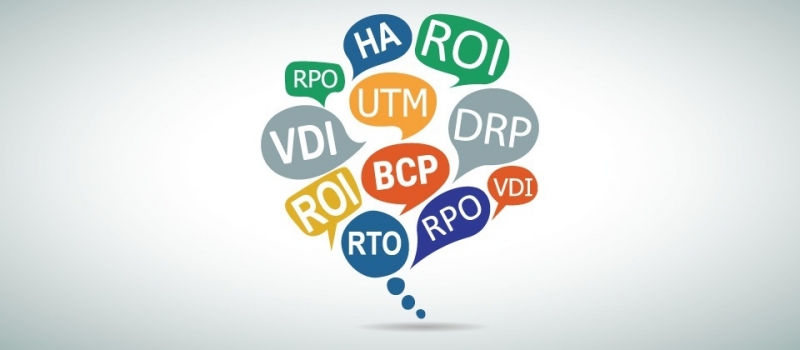Have you tested your DRP plan to determine your RTOs and RPOs so you can craft a high ROI BCP by leveraging a UTM and VDI for HA? No wonder people make fun of IT folks – we’ve got far too much industry jargon. Here’s the low-down on a few popular tech acronyms to help you navigate the sea of complicated terminology and help you make smarter IT strategy decisions.
Return on Investment (ROI): What do you get as result of what you put in? Any investment involves some measure of risk and it requires a particular analysis to determine if the reward is worth the risk. How much value would your business get from anywhere access to email for your team? Do you risk spending the money on infrastructure and services so an IT provider can build this kind of system for you? That depends on the ROI – is the expected boost of productivity going to justify the investment?
Unified Threat Management (UTM): When it comes to network security, nothing can beat a UTM solution. It’s a comprehensive security solution that includes firewall, antivirus, spam blocking, and content filtering. The main idea is that your network can’t afford to allow threats to have their way with your data, so the UTM keeps threats out of your network in the first place, and quickly neutralizes those that are detected. No consumer routers here!
Virtual Desktop Infrastructure (VDI): VDI is the practice of hosting a desktop operating system (typically Windows) within a virtual machine (VM) running on a centralized server. Users access the desktop environments over a network using a remote display protocol; in other words, nothing runs locally on the user machine. Citrix XenDesktop is a classically famous example of VDI. Hosting your apps and data in the cloud means nothing gets stored or managed on the local devices. Great for security and system management.
High-Availability (HA): Having an IT system or process that continuously operational. If your email and remote access system are built for HA, they don’t go down. HA is achievable when technologies like automatic failover systems, redundancy, and clustering (for distributed and shared computing and storage workloads) are baked into the critical parts of your IT infrastructure.
Disaster Recovery Plan (DRP): What would your team do if your office burned down and you needed to get your business up and running? The answer to that question is your DRP. It’s not just about data backup – a DRP involves knowing how and when you can recover backed up data in case of disaster as well as restore access to displaced users.
Business Continuity Plan (BCP): Some business owners confuse their BCP with a data backup strategy, but in reality, the two are much different from one-another. In fact, backups are only one part of the BCP. The business continuity plan is how your business will deal with issues which might affect your business’s ordinary operations, like a major disaster, death or illness, employee turnover, and more. In other words, even unlikely scenarios should be considered in order to provide your business with the greatest likelihood of continuing operations as long as possible.
Recovery Point Objective (RPO): Your RPO is a critical part of your BCP. It is the maximum targeted period in which data might be lost from an IT service due to a major incident. The RPO gives systems designers a limit to work to. For instance, if the RPO is set to four hours, then in practice, off-site mirrored backups must be continuously maintained – a daily off-site backup on tape will not suffice. Your RPO answers the question: “how much data can we safely lose and our business still be ok?”
Recovery Time Objective (RTO): Your RTO is the targeted duration of time within which a business process must be restored after a disaster (or disruption) in order to avoid unacceptable consequences associated with a break in business continuity. Your RTO answers the question “how long will it take to get the business back up and running after a disruption or disaster?” Both the RTO and RPO play a critical role in your BCP.
[hs_action id=”1323″]




